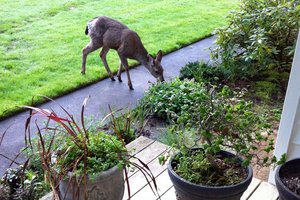 7 Landscaping Mistakes That Wreck Curb Appeal
7 Landscaping Mistakes That Wreck Curb Appeal
Don’t let badly designed or maintained landscaping wreck your home’s curb appeal. Here are pitfalls to avoid.
Clumsy, neglected, and hodgepodge landscaping not only hurts your home’s curb appeal, it can cut the value of your property and make it harder to sell.
Real estate appraisers say bad landscaping is a buyer turnoff that can increase the number of days a property languishes on the market, which also hurts prices.
“I’ve been with clients who won’t even go into a house because of the bad landscaping outside,” says Mack Strickland, a Chester, Va., REALTOR® and appraiser.
Even more important, bad landscaping is a downer that hurts the way you see and enjoy your home.
Don’t let bad landscaping happen to you. Here are the seven landscaping mistakes that bust, rather than boost, your home’s curb appeal.
1. Planting Without A Plan
Some landscaping choices, such as a line of begonias, will last a season; others, like trees, can last a lifetime. So, take time to plan and plot a yard that gives you maximum enjoyment and curb appeal.
For the design challenged, landscape architects are worth the investment ($300-$2,500 depending on yard size). They will render elevations of your future yard, and provide plant lists so you can install landscaping yourself.
Related: How to Create a Landscaping Plan on a Budget
2. Too Much Togetherness
Yes, planting in clusters looks way better than installing single plants, soldier-like, throughout your yard. But make sure your groups of perennials, shrubs, and trees have plenty of room to spread, or they’ll look choked and overgrown. Also, over-crowded landscaping competes with itself for food and water, putting the clusters at risk, especially during drought.
Google how high and wide the mature plant will be, and then combine that info with the spacing suggestions on planting labels. At first, garden beds of young plants will look too airy and prairie-like. But within three years, your beds will fill in with room to grow.
Remember: First year it sleeps, second it creeps, third it leaps.
3. Zoning Out
Don’t be seduced by catalog plants that look gorgeous on paper but aren’t suited to your hardiness zone. You’ll wind up with plants that die prematurely, or demand winter covers, daily watering, and other intensive efforts to keep them alive and well.
Check plant labels to see which hardiness zones are best for your plants.
4. More of the Same
Resist the design temptation to carpet-bomb your yard with your favorite plant or shrub, which will create a boring, monochromatic landscape. Worse, your yard will look great when your fave flowers bloom, then will look drab the rest of the year.
Mix things up and strive for four-season color. For example, combine spring-blooming azaleas with summer-blooming roses and autumn-blazing shrubs — such as burning bushes (Euonymus alatus). For winter color, try the red osier dogwood (Cornus stolonifera), a hardy shrub that sports bright-red branches in winter.
Related:
9 Winter Plants that Dazzle Even in Snow
Winter Gardening: Plants that Provide Beauty All Year Round
5. Refusing to Bury Your Dead
Nothing wrecks curb appeal faster than rows of dead or dying shrubs and perennials. So quickly remove your dearly departed landscaping from your front and side yards.
Spent plants that lived their natural lives are good candidates for a compost pile — if you grind them first, they’ll decompose faster. But if your landscaping succumbed to disease or infestation, it’s best to inter them in black plastic bags, then add to the trash.
6. Weeds Gone Wild
Weeds not only wreck the look of your landscaping, they compete with pricey vegetation for water and food. Weeds also can shorten the life of brick, stone, and pavers by growing in mortar cracks.
The best way to stop weeds is to spread a pre-emergent about three weeks before weed seeds typically germinate. If you can’t stop them from growing, at least get rid of weeds before they flower and send a zillion weed seeds throughout your yard.
7. Contain Those Critters
Deer, rabbits, and other backyard pests think your landscaping is an all-you-can eat buffet, leaving you with denuded branches and topless perennials.
If you’ve got a critter problem:
- Plant deer- or rabbit-resistant varieties. Your local extension agent can provide a list of green things critters won’t eat in your area.
- Install an electric fence around landscaping you want to protect.
- Spray plants with critter repellent. After a hard rain, spray again.
Related:
Flower Garden Mistakes to Avoid
Does Landscaping Give a Good Return on Investment?
Read more: http://members.houselogic.com/articles/landscaping-mistakes-wreck-curb-appeal/preview/#ixzz32NyBKaAG
Follow us: @HouseLogic on Twitter | HouseLogic on Facebook
 Facebook
Facebook
 X
X
 Pinterest
Pinterest
 Copy Link
Copy Link


